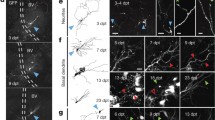Abstract
During development, each neuron acquires a set of iDentifyinG features by which it can be recognized. These include the position of the cell body, the morphology and distribution of processes, both dentritic and axonal, the connections the neuron makes as well as the presence of transmitters and certain “luxury” molecules. Since in the central nervous system (CNS) no neuron ever develops in isolation, it is important to know to what extent the context in which a neuron develops defines its identifying features and to understand how individual neurons interact to establish the characteristic organization of a particular region. There are a number of approaches which may be adopted to address this question. One which we have found to be particularly advantageous has been to take regions of the developing nervous system out of their natural context, transplant them to anomalous positions, and determine the degree to which they express their normal identity.
Access this chapter
Tax calculation will be finalised at checkout
Purchases are for personal use only
Preview
Unable to display preview. Download preview PDF.
Similar content being viewed by others
References
Braekevelt, C. R., HollenberG, M. J. (1970). The Development of the retina of the albino rat. Am. J. Anat. 127, 281–302.
Clavert, A. (1974). InciDents Des anomalies De la fente colobomique sur la miGration Des fibre optiques. Arch. Ophthalmol. (Paris) 34, 215–224.
Constantine-Paton, M., Law, M. I. (1978). Eye-specific termination banDs in tecta of three-eyeD froGs. Science 202, 639–641.
Giroud, A., Martinet, M., Roux, C. (1962). MiGration abnormales Des fibres optiques et consiDérations Générales. Arch. Anat. (StrasbourG) 45, 177–190.
Houlé, J. D., Das, G. D. (1980). FreezinG of embryonic neural tissue and its transplantation in the rat brain. Brain Res. 192, 570–574.
Itaya, S. K. (1980). Retinal efferents from the pretectal area in the rat. Brain Res. 201, 436–441.
Jaeger, C. B., Lund, R. D. (1980). Transplantation of embryonic occipital cortex to the tectal reGion of newborn rats: A light microscope study of orGanization and connectivity of the transplants. J. Comp. Neurol. 194, 571–597.
La Vail, M. M., Hild, W. (1971). Histotypic orGanization of the rat retina in vitro. Z. Zellforsch 114, 557–579.
Lund, R. D. (1981). Transplantation as a tool in the analysis of Development of the rat’s visual system. In: New Approaches in Developmental NeurobioloGy. Gottlieb, D. (ed.). BethesDa, MD.: Society for Neuroscience.
Lund, R. D., Harvey, A. R. (1981). Transplantation of tectal tissue in rats. I. OrGanization of transplants and pattern of Distribution of host afferents within them. J. Comp. Neurol. 201, 191–209.
Lund, R. D., McLoon, S. C. (1980). CytoloGy and connections of retinal transplants in rats. Neurosci. Soc. Abst. 6, 823.
McLoon, L. K., Lund, R. D., McLoon, S. C. (1982). Transplantation of reaGGreGates of embryonic neural retinae to neonatal rat brain: Differentiation and formation of connections. J. Comp. Neurol. 205, 179–189.
McLoon, L. K., McLoon, S. C., Lund, R. D. (1981). CultureD embryonic retinae transplanteD to rat brain: Differentiation and formation of proJections to host superior colliculus. Brain Res. 226, 15–31.
McLoon, S. C., Lund, R. D. (1980a). Specific proJections of retina transplanteD to rat brain. Exp. Brain Res. 40, 273–282.
McLoon, S. C., Lund, R. D. (1980b). IDentification of cells in retinal transplants which proJect to host visual centers: A horseraDish peroxiDase study in rats. Brain Res. 197, 491–495.
McLoon, S. C., Lund, R. D. (1983). Development of fetal retina, tectum and cortex transplanteD to the superior colliculus of adult rats. J. Comp. Neurol. (in press).
Perry, V. H. (1979). The Ganglion cell layer of the retina of the rat: A GolGi study. Proc. Roy. Soc. LonD. B 204, 363–375.
Author information
Authors and Affiliations
Editor information
Editors and Affiliations
Rights and permissions
Copyright information
© 1983 Springer-Verlag New York Inc.
About this paper
Cite this paper
Lund, R.D., Mc Loon, S.C. (1983). Retinal Transplants. In: Wallace, R.B., Das, G.D. (eds) Neural Tissue Transplantation Research. Proceedings in Life Sciences. Springer, New York, NY. https://doi.org/10.1007/978-1-4612-5539-0_5
Download citation
DOI: https://doi.org/10.1007/978-1-4612-5539-0_5
Publisher Name: Springer, New York, NY
Print ISBN: 978-1-4612-5541-3
Online ISBN: 978-1-4612-5539-0
eBook Packages: Springer Book Archive




